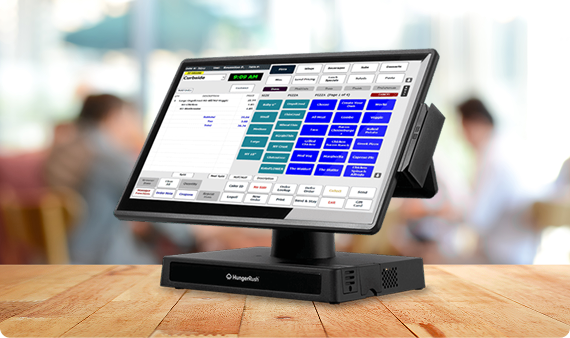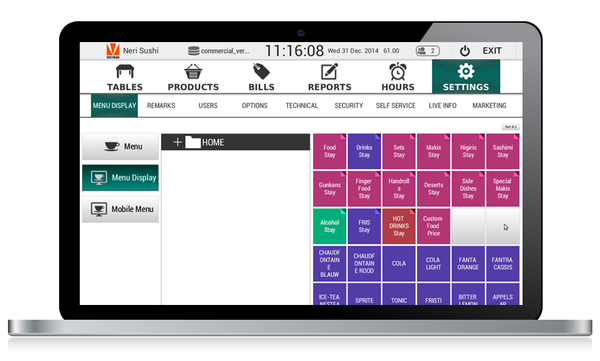Maximize margins using Restaurant POS Software in decision-making workflows
Wiki Article
Exactly How POS System Functions: A Comprehensive Overview for Business Owners
A POS system acts as a necessary device for modern companies, incorporating different elements to streamline operations. It incorporates equipment like barcode scanners and software for sales tracking. This system not just refines transactions but likewise manages inventory and evaluates customer behavior. Recognizing its capability can substantially influence a business's performance and decision-making. What are the crucial elements that contribute to this performance? Checking out these elements provides valuable understandings.Understanding the Parts of a POS System
A Factor of Sale (POS) system is made up of several essential components that function with each other to promote deals and manage business operations. At its core, the hardware consists of tools such as a sales register, barcode scanner, receipt printer, and payment terminal, all important for refining sales (Restaurant POS Software). The software program element takes care of supply, sales tracking, and customer information, supplying valuable insights for business decisions.Additionally, data sources keep transaction documents and customer info, guaranteeing data integrity and protection. Network connection enables real-time updates and accessibility to cloud-based solutions, enhancing functional efficiency. Individual interfaces, designed for simplicity of use, permit personnel to navigate the system promptly, decreasing training time. Together, these parts produce a cohesive system that enhances the sales process, boosts customer care, and aids in reliable management of business sources. Understanding these parts is important for entrepreneur seeking to maximize their POS systemsExactly How Sales Purchases Are Processed
When a consumer makes a decision to make a purchase, the sales purchase starts a series of methodical steps within the POS system. First, the cashier inputs the products being acquired, which are checked through a barcode reader or manually gone into. This activity recovers product details, consisting of prices and applicable taxes, from the system's database.Next, the client exists with the complete quantity due. The POS system after that processes the payment, whether through cash, bank card, or mobile repayment techniques. For electronic repayments, the POS safely interacts with settlement cpus to accredit and verify the transaction.Once the settlement is validated, the system generates a receipt, which can be printed or sent electronically. This invoice offers as receipt for the customer. The purchase data is taped in the system, guaranteeing accurate sales records and monetary tracking for the organization.Stock Administration and Tracking
Reliable supply administration and tracking are important elements of a POS system, as they ensure that organizations keep suitable stock levels and lessen discrepancies. A robust POS system permits real-time inventory updates, reflecting sales and returns instantaneously. This allows entrepreneur to keep an eye on supply degrees precisely, making certain that preferred products are easily offered while preventing overstocking of less prominent products.Additionally, advanced POS systems offer attributes such as computerized supply signals and reorder recommendations, improving the procurement process. Barcoding and RFID technology boost accuracy in tracking stock motion, decreasing human mistake. Considerable coverage devices give insights into stock turnover prices, aiding companies make informed decisions about acquiring and item offerings. Eventually, efficient supply management with a POS system not only enhances functional efficiency but also improves consumer contentment by ensuring item availability.
Analyzing Client Information and Insights
Consumer information evaluation acts as a powerful tool for businesses using a POS system. By collecting and checking out transaction information, organizations can discover valuable insights regarding client behavior and preferences. This evaluation enables them to recognize acquiring patterns, peak buying times, and preferred products, consequently educating supply choices and advertising and marketing strategies.Additionally, businesses can segment their client base, enabling personalized advertising initiatives visite site that satisfy specific demographics or acquiring routines. Understanding customer commitment patterns also assists in developing targeted promos and benefits programs.The data gleaned from a POS system can additionally expose insights into client feedback, making it possible for businesses to make enlightened choices relating to product offerings and solution renovations. Ultimately, leveraging client information successfully can improve the general shopping experience, foster customer satisfaction, and drive profits development.
Benefits of Carrying Out a POS System
Applying a POS system uses countless benefits that can considerably boost business procedures. To begin with, it streamlines deal processes, decreasing wait times and improving client fulfillment. By automating sales procedures, companies can reduce human directory mistake and guarantee exact record-keeping. In addition, a POS system offers beneficial information analytics, allowing owners to track sales fads and supply levels in real-time. This understanding sustains notified decision-making, aiding to enhance stock administration and advertising and marketing strategies.Moreover, many POS systems incorporate with other business devices, such as accounting software program, streamlining financial monitoring. Boosted employee monitoring functions, such as tracking hours and efficiency, further add to operational efficiency.Lastly, the execution of a POS system can bring about boosted revenue through enhanced consumer experiences and critical insights, eventually cultivating company development and sustainability.
Frequently Asked Concerns
What Sorts Of Organizations Can Gain From a POS System?

How Much Does a POS System Normally Cost?
The cost of a POS system generally ranges from a couple of hundred to several thousand bucks, depending on functions, hardware, and software program - Restaurant POS Software. Organizations must take into consideration continuous charges for upkeep, support, and deal handling read this post here when budgeting
Can I Incorporate a POS System With Existing Software?
Incorporating a POS system with existing software program is often viable. Lots of systems use APIs or integrated compatibility features, allowing businesses to improve procedures and enhance capability by connecting various software application applications effectively.What Training Is Needed for Staff to Use a POS System?
Educating for team to make use of a POS system generally includes understanding software program functionalities, refining purchases, handling inventory, and dealing with client communications - Restaurant POS Software. Practical presentations and hands-on practice enhance effectiveness and self-confidence in operation the system efficientlyWhat Happens if the Web Decreases While Making Use Of a POS System?
If the web decreases during POS system usage, purchases may be interrupted. Several systems use offline capacities, allowing fundamental procedures to proceed, however complete functionality, consisting of real-time stock updates, will certainly be limited.Report this wiki page